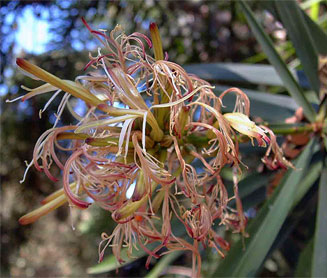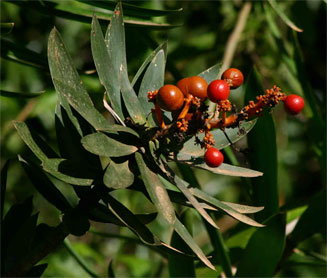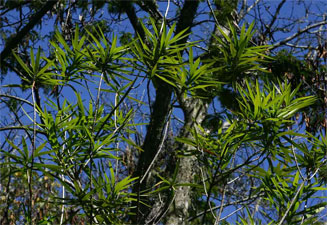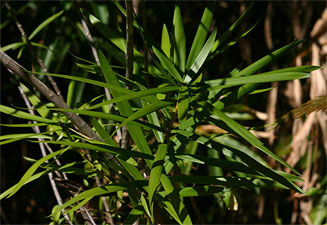Dracaena mannii (Small-leaved
dragon-tree)
[= Dracaena reflexa var. nitens,
Dracaena usambarensis] Asparagus bush,
Asparagus tree, Soap tree [other English names]; Kleinblaardrakeboom
[Afrikaans]
Life
> eukaryotes >
Archaeoplastida >
Chloroplastida
>
Charophyta > Streptophytina > Plantae (land plants)
> Tracheophyta (vascular plants) > Euphyllophyta > Lignophyta (woody plants)
> Spermatophyta (seed plants) > Angiospermae (flowering
plants) > Monocotyledons > Order: Asparagales
> Family: Asparagaceae > Genus:
Dracaena
 |
 |
|
Dracaena mannii, National Botanic Garden,
Harare, Zimbabwe. [photo Rob Burrett ©,
Flora
of Zimbabwe] |
Dracaena mannii, Nyabamba Bridge on the
road to Rusitu Forest, Zimbabwe. [photo Rob Burrett ©,
Flora
of Zimbabwe] |
 |
 |
|
Dracaena mannii, National Botanic Garden,
Harare Zimbabwe. [photos Bart Wursten ©,
Flora
of Zimbabwe] |
A many-branch tree with branches terminating in
rosettes of relatively short (up to 40 cm) and narrow (up to 2 cm)
leaves. Distribution in southern Africa is limited to Kosi Bay area
in South Africa, Mozambique and eastern Zimbabwe. It is widely
distributed in tropical Africa and in these regions is used
extensively for various medicines and has other uses such as for
dyes, soaps, and is planted as a hedge.
Identification
- A many-branched small tree, usually growing from 3-5 m high,
but reaching 12 m in some plants (in West Africa recorded up to
30 m high).
- Has white, papery, smooth bark, marked with leaf scars.
- Leaves grow from 16-40 cm long by 1-2 cm wide and are
relatively small and thin for the genus, thus helping to
distinguish this Dracaena species from others in the
region. Dracaena transvaalensis overlaps in terms of leaf
length (30-50 cm long) but has broader leaves (3-5 cm). The
other three species in the region have leaves generally longer
than 60 cm.
- The cream-coloured flowers are in sprays up to 50 cm long.
They are closed during the day and at night emit a sweet smell.
- The fruit are 2-2.5 cm in diameter and are bright red when
mature.
Distribution and habitat
Widely distributed in Africa from Senegal to
Kenya, southwards to Angola, Mozambique, eastern Zimbabwe, and just
touching into South Africa at Kosi Bay in northern KwaZulu-Natal.
Ecological interactions
- As the flowers emit a sweet smell at night, it is likely
that they are pollinated by moths but there is no evidence of
this at my disposal.
- Fruit are eaten by:
Uses
Uses within southern Africa appear to be fairly
limited, but in tropical Africa, uses are varied and include the
following (information from Burkill 1985):
- Grown as hedges and markers
- Eaten as food (which parts?).
- From a phytochemical perspective the plant evidently has
substances that inhibit the growth of bacterial and fungi. It
yields medicines to:
- stop nausea and vomiting (i.e. antemetics)
- treat cutaneous and subcutaneous parasitic infections
- reduce swelling, oedema and gout
- treat oral complaints
- expel worms (vermifuges)
- treat lung problems, using an extract of the leaf
- reduce pain, using an extract from the bark
- Used as an arrow-poison
- The sap yields red dyes, stains, inks, tattoos and mordants
(i.e. helps fix a dye to fabric or tissue)
- The leaf-ash is used for making soap.
References
- Burkill, H.M. 1985. The useful plants of west tropical
Africa, Vol 3, as accessed from JStor (http://plants.jstor.org/upwta/3_858)
- Palgrave, K.C. and Palgrave, M.C. 2002. Trees of Southern Africa.
3rd Edition. Struik Publishers, Cape Town.
Text by Hamish Robertson |
